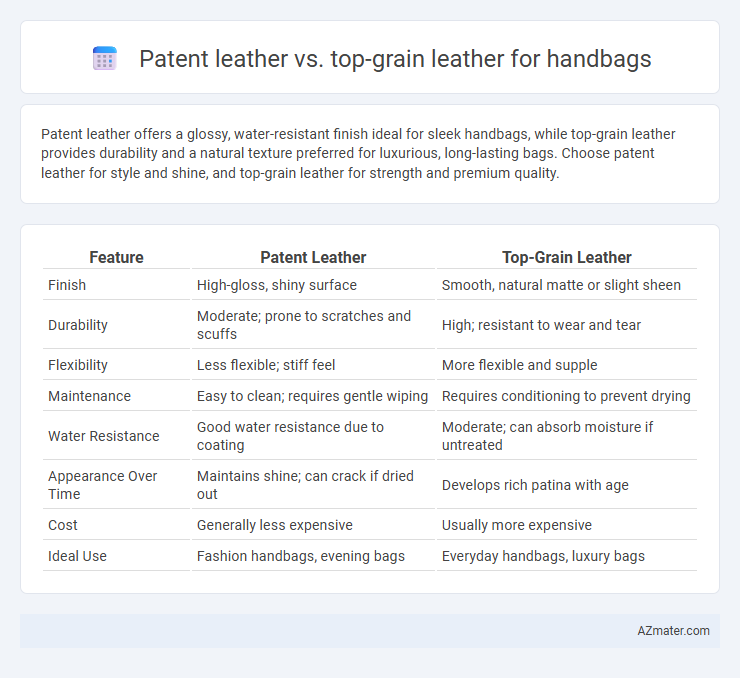Patent leather offers a glossy, water-resistant finish ideal for sleek handbags, while top-grain leather provides durability and a natural texture preferred for luxurious, long-lasting bags. Choose patent leather for style and shine, and top-grain leather for strength and premium quality.
Table of Comparison
| Feature | Patent Leather | Top-Grain Leather |
|---|---|---|
| Finish | High-gloss, shiny surface | Smooth, natural matte or slight sheen |
| Durability | Moderate; prone to scratches and scuffs | High; resistant to wear and tear |
| Flexibility | Less flexible; stiff feel | More flexible and supple |
| Maintenance | Easy to clean; requires gentle wiping | Requires conditioning to prevent drying |
| Water Resistance | Good water resistance due to coating | Moderate; can absorb moisture if untreated |
| Appearance Over Time | Maintains shine; can crack if dried out | Develops rich patina with age |
| Cost | Generally less expensive | Usually more expensive |
| Ideal Use | Fashion handbags, evening bags | Everyday handbags, luxury bags |
Introduction to Patent Leather and Top-Grain Leather
Patent leather features a glossy, high-shine finish achieved through a coating process that enhances its water resistance and aesthetic appeal, making it ideal for elegant handbags. Top-grain leather, derived from the outermost layer of the hide, retains natural grain with a smooth surface and is prized for its durability, suppleness, and ability to develop a rich patina over time. Both materials offer distinct advantages in handbag design, with patent leather excelling in sleek, polished looks and top-grain leather providing a classic, long-lasting texture.
Defining Patent Leather: Features and Composition
Patent leather is a type of coated leather characterized by its high-gloss, mirror-like finish achieved through a lacquer or plastic coating on top of the leather surface. The coating enhances water resistance and durability while maintaining the leather's flexibility and strength. Typically made from lower-grade leather bases such as corrected-grain or splittable cowhide, patent leather's unique composition makes it ideal for handbags that emphasize sleek style and easy maintenance.
What Sets Top-Grain Leather Apart?
Top-grain leather stands out in handbags due to its combination of durability and natural texture, offering a more breathable and flexible material compared to patent leather's glossy, coated surface. Unlike the smooth, shiny finish of patent leather, top-grain leather retains its organic grain patterns and ages with a rich patina, enhancing the handbag's character over time. This type of leather undergoes minimal sanding and buffing, preserving strength while providing a luxurious, matte appearance favored by premium handbag brands.
Visual Appeal: Glossy Shine vs. Natural Texture
Patent leather offers a high-gloss, mirror-like finish that creates a striking, polished look for handbags, ideal for formal or evening wear. Top-grain leather showcases a natural texture with subtle grain patterns, providing a sophisticated, timeless aesthetic that enhances over time with patina. The choice between patent leather and top-grain leather hinges on whether a vibrant shine or organic texture best complements the desired handbag style.
Durability and Longevity Comparison
Patent leather, coated with a glossy finish, offers high resistance to water and stains but is prone to cracking and scuffing over time, reducing its durability for handbags. Top-grain leather, made from the upper layer of the hide, provides superior durability and ages gracefully with a natural patina, making it a longer-lasting choice for handbags. While patent leather prioritizes aesthetics with its shiny surface, top-grain leather excels in longevity and wear resistance, ensuring a handbag endures daily use and environmental exposure.
Maintenance and Care Requirements
Patent leather requires minimal maintenance due to its glossy, sealed surface that resists water and stains, making it easy to wipe clean with a damp cloth. Top-grain leather demands more care, including regular conditioning and protection from moisture to prevent drying and cracking, ensuring longevity and softness. Proper storage away from direct sunlight and heat is essential for both to maintain appearance and durability.
Cost Differences: Investment Value
Patent leather handbags typically cost less upfront than top-grain leather bags due to a more synthetic finishing process, but they may lack the long-term durability that preserves investment value. Top-grain leather is prized for its natural texture and resistance to wear, often maintaining or even appreciating in value with proper care. Investing in top-grain leather offers higher resale potential and longevity, making it a preferred choice for collectors and fashion enthusiasts prioritizing cost-efficiency over time.
Suitability for Everyday Use
Patent leather offers a glossy, water-resistant surface that resists stains and scratches, making it suitable for occasional use but less ideal for daily wear due to its stiffness and tendency to crack over time. Top-grain leather boasts a softer, more flexible texture with natural breathability and durability, which enhances comfort and long-term resilience in everyday handbags. For frequent use, top-grain leather provides better resistance to wear and environmental factors, ensuring the handbag maintains its appearance and functionality.
Sustainability and Environmental Impact
Patent leather requires a chemical coating process involving solvents and plastics, which contributes to higher environmental pollution and lower biodegradability compared to top-grain leather. Top-grain leather, sourced from the outer layer of animal hides, is more sustainable when tanned using vegetable-based methods, minimizing toxic waste and reducing environmental harm. Choosing top-grain leather with eco-friendly tanning aligns better with sustainable fashion practices and reduces the overall carbon footprint of handbags.
Making the Right Choice: Which is Best for Your Handbag?
Patent leather offers a glossy, waterproof finish ideal for handbags requiring high shine and easy maintenance, while top-grain leather provides durability and a natural texture favored for luxury, long-lasting use. Consider patent leather for statement pieces and occasions needing a polished look, whereas top-grain leather suits everyday handbags with its breathability and aging grace. Selecting between patent and top-grain leather ultimately depends on your priorities for style, durability, and handbag function.

Infographic: Patent leather vs Top-grain leather for Handbag
 azmater.com
azmater.com